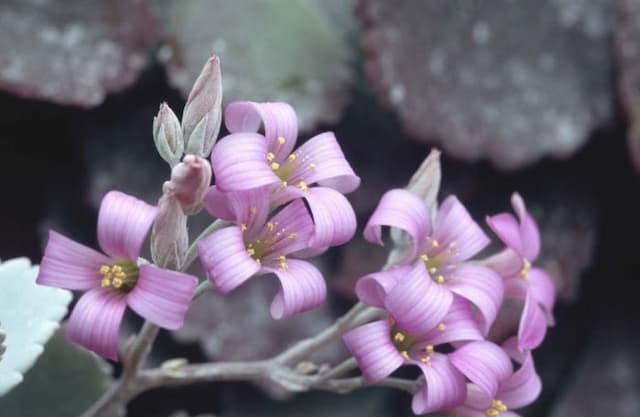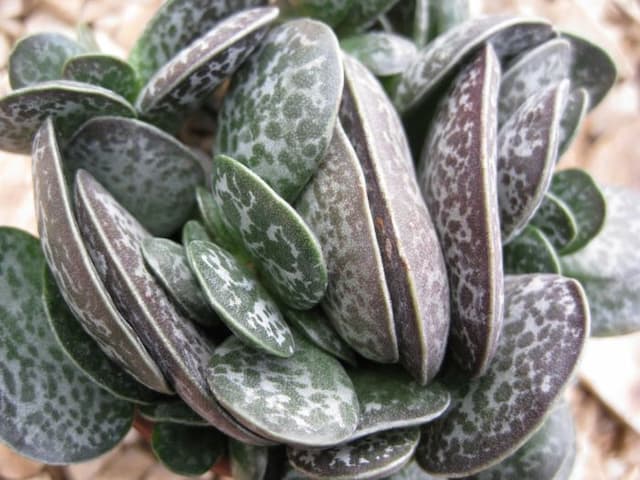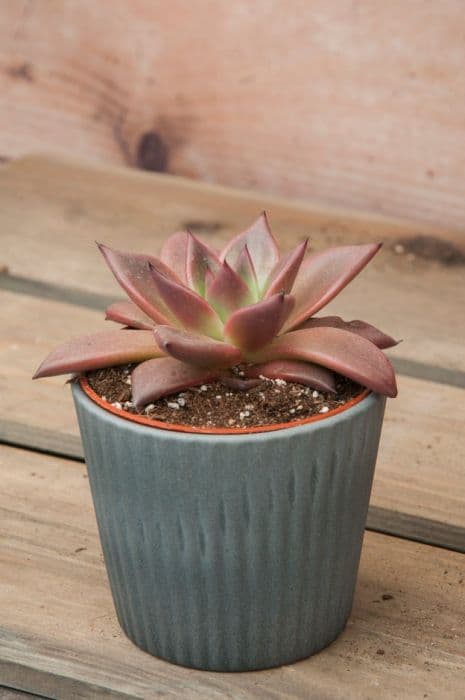Pinwheel Aeonium Aeonium haworthii

ABOUT
Aeonium haworthii, commonly known as "pinwheel aeonium," is a succulent plant with a distinctive appearance characterized by its rosette-shaped clusters of leaves. These fleshy leaves are spoon-shaped and arranged in layers that spiral around a central point, resembling the blades of a pinwheel, hence its common name. The leaves boast a blue-green color with pinkish edges that become more pronounced when the plant is stressed, typically due to sun exposure or a drop in temperature. The overall aesthetic of the pinwheel aeonium is one of symmetry and geometry, with each rosette forming a near-perfect circle as the leaves radiate from the center. The plant's texture adds a unique tactile interest, as the leaves are somewhat waxy and smooth to the touch. This succulent can produce pyramidal towers of small, star-shaped flowers in shades of yellow, which add a delightful contrast to the foliage when they bloom.
About this plant
 Names
NamesFamily
Crassulaceae.
Synonyms
Pinwheel, Haworth's Aeonium, Haworthii, Aeonium Pinwheel.
Common names
Sempervivum haworthii, Aeonium Webb, Aeonium tortuosum, Aeonium decorum, Aeonium mascaense, Aeonium haworthii Webb & Berthel, Aeonium glandulosum, Aeonium haworthii var. haworthii, Aeonium haworthii var. glaucum, Aeonium haworthii var. rubrolineatum.
 Toxicity
ToxicityTo humans
Aeonium haworthii, commonly known as "pinwheel", is not considered toxic to humans. However, it's always advisable to keep plants out of the reach of small children who might ingest plant parts out of curiosity. Ingesting plant parts is not advised as it can potentially cause discomfort or an allergic reaction in some sensitive individuals.
To pets
The pinwheel is also not generally considered toxic to pets. This means that if your dog or cat chews on the leaves, they are unlikely to suffer from any serious toxic effect. However, ingestion can sometimes result in vomiting or diarrhea due to the irritation of the plant matter in the stomach or intestines. As each pet may react differently, it is still wise to discourage pets from eating plants, and if any adverse reactions are observed, consult with a veterinarian.
 Characteristics
CharacteristicsLife cycle
Perennials
Foliage type
Evergreen
Color of leaves
Varies
Flower color
Yellow
Height
2 feet (60 cm)
Spread
2 feet (60 cm)
Plant type
Succulent
Hardiness zones
9
Native area
Canary Islands
Benefits
 General Benefits
General Benefits- Decorative Appeal - Aeonium haworthii, also known as "pinwheel", provides unique visual interest with its rosette-shaped leaves and branching growth pattern.
- Easy Maintenance - This succulent is low-maintenance, requiring minimal watering and able to thrive in a variety of light conditions.
- Drought Tolerance - Pinwheel succulents are highly drought-tolerant, making them an ideal choice for water-wise gardens or for those living in arid climates.
- Propagation Ease - Aeonium haworthii can be easily propagated from cuttings, making it simple to expand your collection or share with friends.
- Adaptability - It can be grown both indoors and outdoors (in mild climates), offering flexibility in placement and usage.
- Seasonal Interest - This plant goes through a dormant period in the summer and then revives in the cooler months, providing seasonal changes in appearance.
 Medical Properties
Medical PropertiesThis plant is not used for medical purposes.
 Air-purifying Qualities
Air-purifying QualitiesThis plant is not specifically known for air purifying qualities.
 Other Uses
Other Uses- Decorative Jewelry - Leaves of the Aeonium haworthii can be used as natural elements in handcrafted jewelry, sometimes being coated in resin to preserve their shape and color.
- Bonsai Accent Plant - Given their unique rosette form, they can serve as an attractive complement to bonsai trees in miniature landscapes.
- Photography Prop - The distinct rosettes offer an interesting subject for macro photography or as a background element in portrait photography to add a touch of green.
- Crafting Material - The fleshy leaves and overall rosette can be used in various DIY crafting projects, including wreath making and mixed-media art.
- Education - Aeonium haworthii can be used in educational settings to teach about plant propagation from leaves and cuttings.
- Living Jewelry - Live plants or cuttings can be incorporated into living necklaces or brooches, where they can root and grow if properly maintained.
- Table Arrangements - Its compact size and unique appearance make it an excellent choice for green table decor during events like weddings or banquets.
- Fairy Gardens - Aeonium haworthii’s rosette form can simulate miniature trees or shrubs in fairy gardens and other small-scale fantasy landscapes.
- Textural Contrast in Arrangements - The plant's rosettes can provide a contrasting texture when used in floral arrangements with other plants or flowers.
- Costuming - Individual leaves or entire rosettes can be incorporated into costumes to add a botanical element, such as for theater productions or cosplay.
Interesting Facts
 Feng Shui
Feng ShuiThe Aeonium haworthii, commonly known as Pinwheel, is not used in Feng Shui practice.
 Zodiac Sign Compitability
Zodiac Sign CompitabilityThe Pinwheel is not used in astrology practice.
 Plant Symbolism
Plant Symbolism- Resilience - Aeonium haworthii, commonly known as Pinwheel, tends to thrive in harsh, dry conditions, symbolizing the ability to endure and persist through difficult times.
- Adaptability - The Pinwheel's ability to store water in its leaves and adapt to its environment represents flexibility and the capability to adjust to changing circumstances in life.
- Renewal - Aeonium haworthii has a lifecycle that allows it to go dormant and return to life with proper conditions, representing rebirth and new beginnings.
- Timelessness - The perennial nature of the Pinwheel, which can live for several years, stands for longevity and timeless value.
 Water
WaterFor the Aeonium haworthii, commonly known as the 'Pinwheel Aeonium', thorough watering is essential when the soil feels dry to the touch. Typically, this might mean every 7 to 10 days during the active growing season, which is generally spring and autumn. In the summer, it might need slightly less water, and in winter, even less—potentially every 3 to 4 weeks—since it's dormant and the plant's water requirements decrease. When watering, aim to provide enough water to see it run through the drainage holes; for a standard pot size, this could be approximately 8-16 ounces. Allow the soil to dry between waterings to prevent root rot
 Light
LightThe Pinwheel Aeonium prefers bright but indirect sunlight. A spot near a south or west-facing window with some shade or filtered light is ideal. Avoid placing it in direct, harsh sunlight for extended periods as that can scorch the leaves. Providing proper light is crucial for maintaining the plant's distinctive rosettes and vibrant colors.
 Temperature
TemperatureThe Pinwheel Aeonium thrives in temperatures ranging from 40 to 100 degrees Fahrenheit, but its ideal growing condition falls between 65 and 75 degrees Fahrenheit. It can survive short periods of colder weather down to around 40 degrees Fahrenheit, but it should be protected from frost. High temperatures over 80 degrees Fahrenheit can cause dormancy in summer, so provide some shade during the hottest parts of the day.
 Pruning
PruningThe Pinwheel Aeonium benefits from occasional pruning to remove any dead or damaged rosettes which promotes better growth and plant health. Pruning should be done in the plant's active growing period, usually in spring or autumn. It's not a process that needs to be done often—once a year or every other year is typically adequate. Always use clean, sharp scissors or pruning shears to make precise cuts.
 Cleaning
CleaningAs needed
 Soil
SoilPinwheel plants prefer well-draining soil. A mix of 50% potting soil, 25% perlite, and 25% sand is ideal. They thrive in slightly acidic to neutral pH, between 5.5 and 7.0.
 Repotting
RepottingPinwheel plants should be repotted every two to three years to refresh the soil and encourage growth.
 Humidity & Misting
Humidity & MistingPinwheel plants prefer moderate humidity levels but are quite adaptable and can tolerate the dry conditions found in most homes.
 Suitable locations
Suitable locationsIndoor
Place Pinwheel in bright, indirect light; water when soil is dry.
Outdoor
Plant Pinwheel in sunny to partial shade; protect from extreme cold.
Hardiness zone
9-11 USDA
 Life cycle
Life cycleAeonium haworthii, commonly known as the Pinwheel Aeonium, begins its cycle as a seed that germinates in well-draining soil with adequate warmth and light. Upon germination, it develops into a rosette of spoon-shaped leaves, which can vary in color from green to blue-green with pink edges. With time the rosette grows and may produce offsets or branch out to form a clump, exhibiting its characteristic pinwheel pattern. The plant reaches maturity and enters the blooming stage, typically in late winter or spring, where it produces pyramidal inflorescences with yellow, star-shaped flowers atop tall, leafy stalks. After flowering, the particular rosette that bloomed usually dies, but the plant continues to live and propagate through the offsets, which then develop into mature rosettes. The cycle continues as these offsets eventually bloom, seed, and give rise to new generations of Aeonium haworthii.
 Propogation
PropogationPropogation time
Spring-Early Summer
Propogation: The Aeonium haworthii, commonly known as pinwheel or Haworth's aeonium, is best propagated through stem cuttings, which is the most popular method. The ideal time to propagate these plants is during their growth period, typically in spring or early summer. To propagate by stem cuttings, choose a healthy, non-flowering stem and cut a 2 to 4-inch (5 to 10 cm) length. Allow the cut end to callous over for a few days in a dry location to reduce the risk of rot. After the cut end has calloused, plant the cutting in well-draining cactus or succulent potting mix. Water sparingly until the cutting has established roots, which can be checked gently by a slight tug on the cutting after a few weeks. Once new growth is apparent, the plant can be transplanted or continued in its current pot with regular succulent care.









